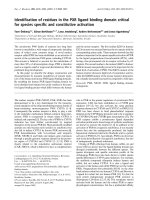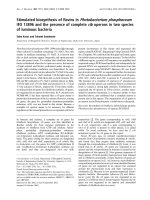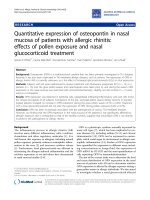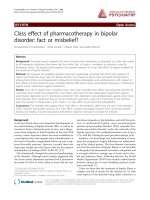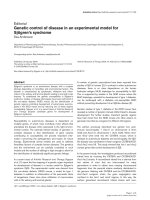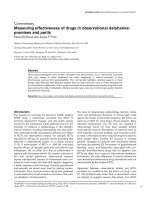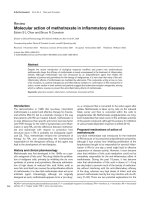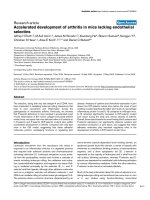Báo cáo y học: "The rise of Bioscience in the East" pptx
Bạn đang xem bản rút gọn của tài liệu. Xem và tải ngay bản đầy đủ của tài liệu tại đây (194.58 KB, 2 trang )
EDI T O R I A L Open Access
The rise of Bioscience in the East
Kuan-Teh Jeang
Abstract
The rapid growth of bioscience in China is considered.
A few days ago, the results of an international standar-
dized test administered to students from 65 countries
were released. The test known as the Program for Inter-
national Student Assessme nt (PISA) was conducted by
the Organization for Economic Cooperation and Devel-
opment a Paris based entity. The
testing involved 5000 students per country of age
15 years and 2 months. The surprising results from the
PISA were that students from China (Shanghai), who
actually participated for the first time, performed uni-
formly better than their cohorts from other countries.
PISA scores are scaled with the average being set at 500.
As reported in the N ew York Times “On the math test,
students in Shanghai scored 600, in Singapore 562, in
Germany 513, and in the United States 487. In reading,
Shanghai students scored 556, ahead of second-place
Korea with 539. The United States scored 500 and came
in 17th, putting it on par with students in the Nether-
lands, Belgium, Norway, Germany, France, the United
Kingdom and several other countries. In science, Shang-
hai students scored 575. In second place was Finland,
where the average s core was 554. The United States
scored 502 – in 23rd place – with a performance indis-
tinguishable from Poland, Ireland, Norway, France and
several other countries.” Although there are many ways
to interpret the results, at face value they speak to the
impressive educational achievements of students in
China.
As globalization trends toward economic parity in
diverse regions, a few years ago I noted some interest-
ing numbers. The statistics from the US National
Science Foundation (NSF) showed that between 1995
and 2005 the output of worldwide science and engi-
neering journal articles grew at an average annual rate
of 2.3 percent, but the US growth rate was much
lower, at an annual 0.6 percent, while the greatest
increase in a nnual article productivity came from Asia:
6.6 percent. One
might surmise that since 2005, growth in Asia (parti-
cularly China) is occurr ing at an even faster rate. In
fact, the latest SCImago
scientific ranking of countries (based on data from
year 2008) now lists China in second place with
231,000 published items, behind the United States
(375,000 published items) and ahead of the third place
United Kingdom (120,630 published items). And it is
not surprising then, that in 2010 the Chinese economy
for the first time surpassed the size of the Japanese
economy, and China has eased into second place
behind only the United States.
TheexperienceatRetrovirology al so verifie s the
rapidly changing China tren d. For example, we surveyed
papers published in Retrovirology over the last three
year (2008, 2009, 2010) for those that come from China,
Hong Kong and Taiwan. In 2008, the number of papers
contributed from these locales was zero. By 2009, the
number had increased to four [1-4]; and in 2010, there
are five papers [5-9]. Indeed, the general uptrend in
scientific productivity from China is reflected tangibly in
papers being published in Retrovirology.
One could view the rapid development of bioscience
in China as a challenge to traditionally held views of
“American exceptionalism”. On the other hand , one also
must realize that diseases know no geographic bound-
aries, and solutions a nd cures developed in America are
good for China and elsewhere; similarly breakthroughs
in biology and medicine in China benefit not only the
East, but also the West, the North, and the South.
Apparently, it is in the latter spirit that non-Chinese
scientists are more and more engaging their Chinese
counterparts through scientific exchanges and atten-
danc e at the increasing number s of meetings being held
Correspondence:
The National Institutes of Health, Bethesda, MD, USA
Jeang Retrovirology 2010, 7:106
/>© 2010 Jeang; licensee BioMed Centr al Ltd . This is an Open Access article distributed under the terms of the Creative Commons
Attribution License ( which permits unrestrict ed use, distribution, an d reproduction in
any medium, provided the original work is prope rly cited.
in China (see examples: />sia/index.html; ; http://
www.meeting.edu.cn/webmedia/oemui/en /index.htm).
One hopes that the rise of science in China presages a
rising tide of scientific progress in many other develop-
ing countries. To the benefit of all, the United States,
Europe, and other developed countries have important
roles to play in fostering the quantity and qual ity of
scientific excellence in the up-and-coming fledgling
nations.
Acknowledgements
The opinions expressed are the author’s personal views and do not
necessarily reflect those of his employer, the National Institutes of Health
(NIH). Work in KTJ’s laboratory is supported in part by intramural funding
from the National Institute of Allergy and Infectious Diseases (NIAID). The
author thanks Mark Wainberg and Ben Berkhout for critical readings of this
editorial.
Received: 8 December 2010 Accepted: 15 December 2010
Published: 15 December 2010
References
1. Chien MP, Lin CH, Chang DK: Recruitment of HIV-1 envelope occurs
subsequent to lipid mixing: a fluorescence microscopic evidence.
Retrovirology 2009, 6:20.
2. Ma L, Guo Y, Yuan L, Huang Y, Sun J, Qu S, Yu X, Meng Z, He X, Jiang S,
Shao Y: Phenotypic and genotypic characterization of human
immunodeficiency virus type 1 CRF07_BC strains circulating in the
Xinjiang Province of China. Retrovirology 2009, 6:45.
3. Kuang YQ, Tang X, Liu FL, Jiang XL, Zhang YP, Gao G, Zheng YT:
Genotyping of TRIM5 locus in northern pig-tailed macaques (Macaca
leonina), a primate species susceptible to Human Immunodeficiency
Virus type 1 infection. Retrovirology 2009, 6:58.
4. Kok KH, Lei T, Jin DY: siRNA and shRNA screens advance key
understanding of host factors required for HIV-1 replication. Retrovirology
2009, 6:78.
5. Wang X, Lv F, Gao G: Mutagenesis analysis of the zinc-finger antiviral
protein. Retrovirology 2010, 7:19.
6. Li L, Qiao P, Yang J, Lu L, Tan S, Lu H, Zhang X, Chen X, Wu S, Jiang S,
Liu S: Maleic anhydride-modified chicken ovalbumin as an effective and
inexpensive anti-HIV microbicide candidate for prevention of HIV sexual
transmission. Retrovirology 2010, 7:37.
7. Chitra E, Lin YW, Davamani F, Hsiao KN, Sia C, Hsieh SY, Wei OL, Chen JH,
Chow YH: Functional interaction between Env oncogene from Jaagsiekte
sheep retrovirus and tumor suppressor Sprouty2. Retrovirology 2010, 7:62.
8. Liu L, Wan Y, Wu L, Sun J, Li H, Li H, Ma L, Shao Y: Broader HIV-1
neutralizing antibody responses induced by envelope glycoprotein
mutants based on the EIAV attenuated vaccine. Retrovirology 2010, 7:71.
9. Wen M, Arora R, Wang H, Liu L, Kimata JT, Zhou P: GPI-anchored single
chain Fv–an effective way to capture transiently-exposed neutralization
epitopes on HIV-1 envelope spike. Retrovirology 2010, 7:79.
doi:10.1186/1742-4690-7-106
Cite this article as: Jeang: The rise of Bioscience in the East.
Retrovirology 2010 7:106.
Submit your next manuscript to BioMed Central
and take full advantage of:
• Convenient online submission
• Thorough peer review
• No space constraints or color figure charges
• Immediate publication on acceptance
• Inclusion in PubMed, CAS, Scopus and Google Scholar
• Research which is freely available for redistribution
Submit your manuscript at
www.biomedcentral.com/submit
Jeang Retrovirology 2010, 7:106
/>Page 2 of 2

